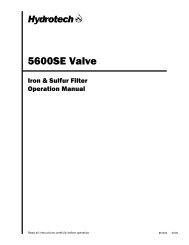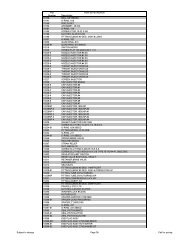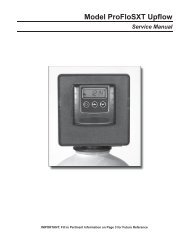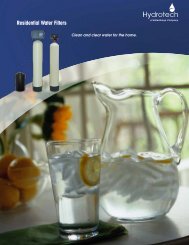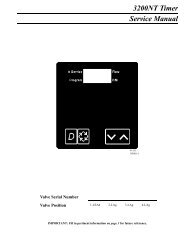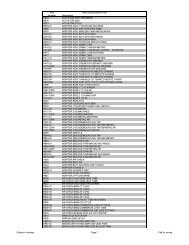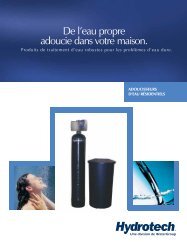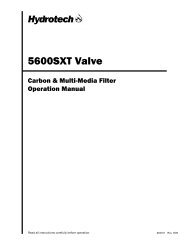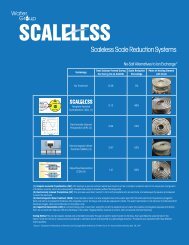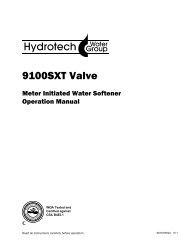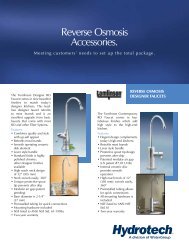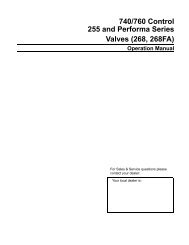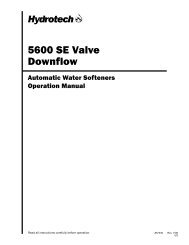5600 Calendar Clock Valve - Hydrotech
5600 Calendar Clock Valve - Hydrotech
5600 Calendar Clock Valve - Hydrotech
Create successful ePaper yourself
Turn your PDF publications into a flip-book with our unique Google optimized e-Paper software.
CAUTION:<br />
If the ground from the electrical panel or breaker box to the water<br />
meter or underground copper pipe is tied to the copper water lines<br />
and these lines are cut during installation of the Noryl bypass<br />
valve and/or poly pipe, an approved grounding strap must be<br />
used between the two lines that have been cut in order to maintain<br />
continuity. The length of the grounding strap will depend upon the<br />
number of units being installed and/or the amount of copper pipe<br />
being replaced with poly. See Figure 1.<br />
In all cases where metal pipe was originally used and is later<br />
interrupted by poly pipe or the Noryl bypass valve as in Figure 1<br />
or by physical separation as in Figure 2, to maintain proper<br />
metallic pipe bonding, an approved ground clamp c/w not less<br />
than #6 copper conductor must be used for continuity.<br />
Check your local electrical code for the correct clamp and cable<br />
size.<br />
Installation Instructions<br />
2<br />
Figure 1<br />
Ground<br />
From<br />
Panel<br />
Poly Pipe<br />
Figure 2<br />
Electrical Panel<br />
Ground Strap<br />
Poly Pipe<br />
Softener<br />
c/w Plastic Bypass<br />
Copper Pipe<br />
Water Meter<br />
Outside Water Line For Outside & 3rd Tap Comes From Meter<br />
Unfiltered Water Bypass<br />
Loop Cut & Capped<br />
Filtered Water Line in Home<br />
Ground Strap Required<br />
Because of Break in Continuity<br />
1. Determine the best location for your water softener, bearing in mind the location of your water supply lines, drain line<br />
and 110 volt AC electrical outlet. Subjecting the softener to freezing or temperatures above 110°F (43°C) will void the<br />
warranty.<br />
2. Water to supply outside faucets used to water lawns and gardens should not be softened. A new water line is often<br />
required to be connected to supply hard water to the inlet of the water softener and to the outside faucets. Cut the<br />
water line between where it enters the house; before any lines that branch off to feed the hot water heater or other<br />
fixtures in the house; and as near the desired location of the water softener as possible. Install a tee fitting on the feed<br />
end of the cut pipe and an elbow fitting on the other end. Install piping from the tee to the inlet of the water softener<br />
and from the elbow to the outlet to the softener. To server the water lines which branch off to feed outside faucets, cut<br />
the branch lines approximately two inches from the fitting on the main water line. Install an elbow on the end of the<br />
pipe nearest the outside faucet and a cap on the end connected to the existing water line. Install piping from the tee<br />
on the inlet to the water softener to the elbow on the pipe to the outside faucet. Following this procedure will result in<br />
all lines in the house, with the exception of the outside faucets but including the water heater and therefore the hot<br />
water lines, being supplied with soft water.<br />
3. Familiarize yourself with the location of the inlet, outlet and drain on the control valve. Be very careful not to get the<br />
controls wet.



